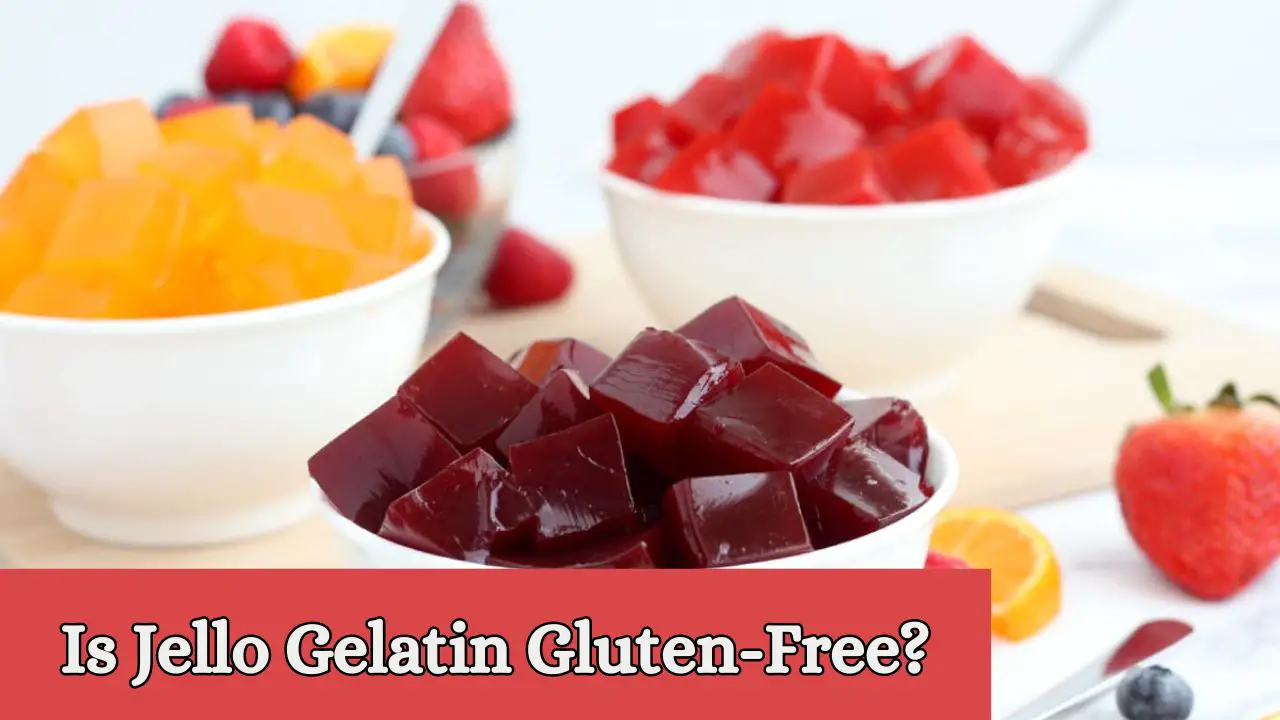Is Jello Gelatin Gluten-Free? Find Out the Answers

The gluten-free diet has significantly increased in popularity in recent years. People are more aware of their dietary limitations and health issues. One such query that often arises is whether Jello gelatin is gluten-free.
Jello gelatin is considered gluten-free. The primary ingredient in Jello is gelatin. It is a protein derived from animal collagen. Usually obtained from the skin, bones, and connective tissues of cows or pigs. Gelatin itself does not contain gluten. However, it is essential to be cautious about the specific Jello product you choose. In fact, some varieties contain gluten in the form of added ingredients. These include flavourings, thickeners, or stabilisers that may contain gluten.
In this article, we will delve into the origins of gelatin. Also, explore its production process. Also, sheds light on whether Jello gelatin is gluten-free. So, let’s unravel the truth behind this beloved dessert and see if it meets the dietary requirements for gluten-free eating.
Does Jello Have Gluten in It?
Jello gelatin products were generally considered gluten-free. It’s also eggless and dairy-free. The main ingredient in Jello is gelatin. Now the question is, is gelatin gluten free?
Gelatin is produced from the collagen of animals. It comes from pig’s or cow’s skin, connective tissues, and bones. No wheat, barley, rye, or products derived from these grains are used to make gelatin. Henceforth, it is gluten-free.
Gluten is essentially a blend of proteins. Wheat, barley, rye, and goods derived from those grains all contain it. Even a food item called cream of wheat contains gluten. There are two proteins in gluten: gliadin and glutenin. But gluten has adverse side effects. Furthermore, not every Jell-O product is gluten-free certified. Because some flavours of Jello contain gluten. So, some of them have gluten in it.
Is Jello Pudding Gluten Free?
From animal products, gluten-free gelatin sources for Jello. But some of the puddings are not gluten free. Basically, the gluten-free status of pudding depends on the specific flavour and formulation. However, you have to know the basic Jello pudding ingredients.
Ingredients for Jello Instant Pudding (basic):
- Sugar
- Modified Cornstarch
- Disodium Phosphate (for Thickening)
- Contains Less than 2% of Natural and Artificial Flavor
- Salt
- Tetrasodium Pyrophosphate (for Thickening)
- Mono- and Diglycerides (prevent foaming)
- Artificial Colour
For different flavours or varieties of Jello pudding, the ingredients may vary. Any of the ingredients contain gluten. The gluten-free status of this pudding varies depending on the specific flavour and formulation. The same goes for sugar-free or strawberry Jello. Yet, some of them are gluten-free, but not all of them.
Which Brands of Gelatin Are Gluten-Free?
Mostly, available gelatin brands are gluten free. Kraft Jell-O gelatin is the most popular among them. Except the Jell-o brand gluten-free gelatin brands are:
- Simply Delish
- Bakol
- Great Lakes Gelatin
- Dr. Oetker Organics
- GoBIO!
- Knox original gelatin
- Great Lakes kosher gelatin
- Vital proteins beef gelatin
All these gelatin brands are made from factory farmed animals.
However, there are vegan gelatins also available. They are made from grains too.
But the grains are gluten-free as all the grains don’t contain gluten. Here is the list of some gluten-free grains as follows
- Rice (all varieties, including white, brown, basmati, and jasmine)
- Quinoa
- Buckwheat
- Amaranth
- Millet
- Sorghum
- Teff
- Corn (cornmeal, corn flour)
- Oats (pure, uncontaminated oats – check for gluten-free labelling)
- Wild rice
Some popular Vegan-friendly gluten-free Jello options are Now Real Food, Let’s Do Organic, Garden Dessert, and Green. These brands provide vegan gluten-free gelatin. Gobio, Simply Delish also provides egg-less, dairy-free, gluten-free, vegan gelatin. There are vegan substitutes for gelatin. For instance, agar-agar, carrageenan, and pectin make vegan gelatin desserts.
Homemade Gluten-free Jello Recipes
For your convenience, we have tried to share a strawberry jelly recipe. The gluten-free Jello recipes that you can try:
Homemade Strawberry Jello
In this recipe, use fresh strawberries and agar agar powder. You can prepare a tasty and healthy gluten-free jelly with only a few basic ingredients.
Ingredients
2 cups fresh strawberries, cleaned and chopped
1/2 cup water
1/2 cup sugar
1 tablespoon agar powder
Instructions
Step 1: Blend the strawberries to make strawberry puree.
Step 2: Now combine the agar agar powder, water, and sugar in a saucepan. Maintain a medium-low flame.
Step 3: Combine sugar and agar agar powder. Stir until combined.
Step 4: Pour the strawberry puree into the pan. Stir continuously.
Step 5: Combine them thoroughly.
Step 6: Pour the mixture into cups or a Jelly mould.
Step 7: Chill until the dish is set. It will probably take two hours.
Apart from strawberries, you can also use oranges, berries, and grapes.
How Do I Make a Jello Gelatin Dessert?
A Jelly gelatin dessert is easy and enjoyable to make. You may think how do you make Jello from gelatin packets? Here is a simple recipe to help you with the process:
Ingredients
1 box of flavoured gelatin, such as strawberry, raspberry, or lime (3 oz or 85g).
Boiling water in 240 ml or one cup of cold water
Optional toppings
1/2 cup of whipped cream or fresh fruit.
Instructions
Boil the water: Heat one cup of water in the cattle.
Mix the gelatin: Combining the gelatin Place the gelatin packet’s contents in a heat-resistant bowl.
Add boiling Water: Use the flavour of your choice, of course. Pour boiling water over the gelatin powder. Stir it completely to dissolve the gelatin.
Normally, this takes two minutes.
Add cold water: Fill the bowl with the gelatin mixture that has been dissolved with one cup of cold water. To combine, stir.
Refrigerate: Put the bowl containing the gelatin mixture in the refrigerator to chill. As per the directions on the gelatin package, this should chill for at least four hours to set.
Check the firmness: Verify firmness: Gently press your finger on the surface to see if the gelatin has hardened. It ought to be solid and resilient.
Optional garnish: For additional flavour and decoration, you can sprinkle some fresh fruit or a dollop of whipped cream on top of the gelatin that has set.
Prepare and eat: It’s ready to serve once the gelatin has set and any desired toppings have been added. It can be served in the same bowl or divided into smaller portions.
Keep in mind that you can get creative with Jelly gelatin desserts by adding various flavours, fruits, or even layers of various
What Should I Do to Ensure A Safe Gluten-Free Jello Experience?
If you want a Gluten-free lifestyle, including Jello consumption, that’s possible.
If you are looking to ensure a safe gluten-free Jello experience, here are some tips to keep in mind:
Check the label: Look for Jello product labels to determine whether they contain gluten. Initially, It’s best to double-check the label, even though Jelly products are generally thought to be gluten-free. Plus, check for any potential gluten sources that might be concealed. When making jelly, avoid cross-contamination if you have celiac disease or a gluten allergy. To avoid Gluten cross-contamination risks, use clean utensils. Avoid using ingredients that contain gluten.
Use gluten-free ingredients: Use gluten-free ingredients to make homemade Jello. Use agar agar powder instead of gelatin. Agar agar is the best option if you want a plant-based substitute.
Be aware of additives: Some Jello products contain additives or flavourings with gluten. Always check the label. Do your research to ensure that the product is safe for you to consume.
Choosing gluten-free Jello products: Look at the following guidance. Choose gluten-free Jelly products that satisfy your dietary requirements:
Pay attention to the label: On the container, look for products marked as “gluten-free” or “certified gluten-free”. By doing this, it is ensured that the thing has undergone testing and complies with gluten content requirements.
Look for substances that contain gluten: Read the ingredient list thoroughly to look for any possible gluten sources, such as wheat, barley, rye, or their byproducts.
Side Effects of Consuming Jello Gelatin
It is possible to have celiac disease or non-celiac gluten sensitivity if you are allergic to gluten. Some common symptoms of celiac disease include:
- Diarrhoea
- Abdominal pain and bloating
- Weight loss
- Fatigue and weakness
- Iron, calcium, and vitamin D deficiencies
- Anaemia
- Skin rashes (dermatitis herpetiformis)
- Joint pain
- Irritability and mood changes
- Delayed growth and puberty in children
You have to stick to recommendations for a gluten-free diet if you think you may be sensitive or allergic to gluten.
Frequently Asked Questions (FAQs)
Is Jello gluten-free, dairy-free and vegan?
Jello is gluten-free because its main ingredients are gelatin and sugar. They both don’t contain gluten. However, jelly is not dairy-free because some of its products contain milk or milk byproducts. Furthermore, some of them are not vegan as they contain gelatin. And we know that gelatin is derived from animal collagen.
What brand of Jell-O is gluten-free?
There are plenty of gluten-free jellies on the market. Kraft, simply Delish, Baklo, Bogio. Among all of them, the certified and committed Jello brand is. However, grab any of them and enjoy a gluten-free lifestyle.
Is Gelatin always in Jello?
Yes, gelatin is an important component of classic Jelly gelatin desserts. Kraft Foods owns the Jello brand. The main ingredients in their gelatin desserts are gelatin, flavourings and sweeteners. In fact, gelatin is responsible for the jiggly, wobbly texture of Jelly.
Conclusion
In the end, we hope you know that Jello gelatin is gluten-free. Most of them are gluten-free. Also, we have found some vegan jelly. Exploring the truth about gluten in gelatin, it will be easy for you to have gluten-free Jello consumption. However, it is essential to verify the information on the product label or get in touch with the manufacturer. as different manufacturing techniques and ingredient formulations exist. Above all, to ensure complete safety, people with celiac disease or severe gluten sensitivity choose products that are certified gluten-free. Always be knowledgeable and make educated decisions to satisfy particular dietary needs and preferences.





